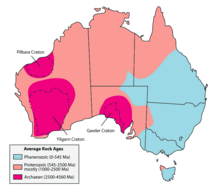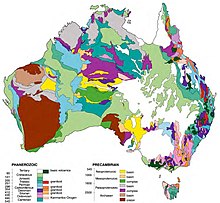

Victoria is an Australian state, situated at the southern end of the Great Dividing Range. The Great Dividing Range stretches along the east coast of the continent and terminates near the Victorian city of Ballarat west of the capital Melbourne, though the nearby Grampians may be considered to be the final part of the range. The highest mountains in Victoria (just under 2,000 m) are the Victorian Alps, located in the northeast of the state.
The northwest of the state is mostly Cainozoic rocks while the southeast is primarily made up of Palaeozoic rocks.[1] There have been no discoveries of Precambrian rocks in Victoria.
The low flat northwest of the state that borders the Murray River was once the bed of an ancient sea and the land is much afflicted with salinity. Saline drainage from Victorian land is one of the sources of the salinity problem in the Murray–Darling River system. Commercial salt evaporation is undertaken near Swan Hill.
Central and western Victoria comprise world-class vein-hosted gold deposits, hosted mostly in the extensive Ordovician turbidites.
The southeast of the state has enormous brown coal fields.[2]
- ^ Macdonald, J. Reid; Mary Lee Macdonald; Patricia Vickers-Rich; Leaellyan S. V. Rich; Thomas H. Rich (1997). Fossil collectors guide. Kangaroo Press. p. 155. ISBN 086417845X.
- ^ "Coal". 13 May 2019.
© MMXXIII Rich X Search. We shall prevail. All rights reserved. Rich X Search
